
Can Ansay the founder of AI streaming and marketplace platform Musixy.ai, says AI-generated music is revolutionary and brings efficiency and lowers costs to productions.
Cryptocurrency Financial News

Can Ansay the founder of AI streaming and marketplace platform Musixy.ai, says AI-generated music is revolutionary and brings efficiency and lowers costs to productions.
The crypto industry is known for its sheer price movement volatility, driven mainly by events and liquidity crunches. Since the beginning of the year, there has been a noticeable and consistent outflow of cash from the cryptocurrency market, which is unsurprising.
According to Bitfinex’s latest report, this capital drain was evident in August, as the crypto market saw an exit of about $55 billion in capital from major cryptocurrencies.
Bitfinex’s analysis, which measured the aggregate realized value metric of Bitcoin (BTC), Ethereum (ETH), and major stablecoins like Tether’s USDT, USD Coin (USDC), BUSD, Dai, and TrueUSD (TUSD), indicates that about $55 billion in capital exited the market in August.
Although the market struggled for most of the first half of the year, things became different in July as Bitcoin spearheaded inflows. During this period, Bitcoin crossed $30,000 for a while as over $100 billion has entered the market. However, the momentum changed in early August, as profit-taking and continued mixed signals from the US economy triggered outflows.
“A deep dive into the data reveals a prevailing trend: by early August, the industry had begun to experience capital outflows,” said the report.
Interest from institutional investors during this period, especially, started to wane as digital asset investment funds registered outflows after four weeks of heavy inflows. The trend has continued to the time of writing, as the run of outflows now totals $294 million.
The report from Bitfinex shows that August’s capital drain was the biggest this year, especially for Bitcoin. Most of this drain came from two isolated events, resulting in immense price movement in a relatively short period. In particular, the August 17 flash crash saw Bitcoin’s price drop by 11.4% in a few hours.
“August was the largest red monthly candle for BTC since the bear market bottom was formed in November 2022 at –11.29 percent as per Bitfinex Data.”
The crypto derivative market has also had a similar trajectory. Ether (ETH) futures and options markets have slowed considerably in 2023. The average daily trading volume is down almost 50% from the two-year average to $14.3 billion daily.
Bitcoin has also seen some liquidity crunches, as data shows almost 69% of all mined Bitcoin have not moved in over a year. On the other hand, this suggests a high conviction from investors and a buoyant outlook on the future of the digital currency.
September has been relatively quiet regarding price movement, and the industry awaits the beginning of the next bull market. However, this crypto exchange founder believes that a bull run already started in March but the market is yet to catch on.
These changes are supposed to boost the value of iota tokens for holders and investors, alongside improving network security.
“It’s important to us to build a custodian without the risks of securing many altcoins within the same trust company as bitcoin,” Cory Klippsten, CEO of Swan, said.
The latest price moves in bitcoin (BTC) and crypto markets in context for Sept. 15, 2023. First Mover is CoinDesk’s daily newsletter that contextualizes the latest actions in the crypto markets.
Paxos paid $520,000 for a $2,000 bitcoin transaction earlier this week.
Cardano (ADA) has been making waves recently, pulled up by a newly found enthusiastic demand pressure at the $0.24 support level. Investors and enthusiasts are eagerly watching to see if this bullish trajectory is solid enough to inspire confidence in a more extended recovery.
After a period of uncertainty, ADA’s price has seen a resurgence, thanks in part to the $0.24 support level. This renewed demand has ignited a relief rally, catching the attention of traders and analysts alike. But, the question on everyone’s mind is whether this upward momentum can be sustained.
According to a recent price analysis, if the current buying momentum persists, ADA could appreciate by another 3% within the week. This modest yet encouraging gain hints at the cryptocurrency’s resilience. However, there’s a significant obstacle standing in the way of a more substantial bullish turn.
As of the latest available data, ADA is priced at approximately $0.254026 on CoinGecko, with a 2.6% gain in the last 24 hours and a slight 1.3% decline over the past seven days.
A formidable dynamic resistance level has thwarted bulls’ attempts to push ADA higher on three distinct occasions in the past. To inspire true confidence in a prolonged uptrend, ADA’s price must decisively breach this overhead resistance.
Analysts suggest that achieving this feat could have a cascading effect, repositioning the resistance as newfound support. If this occurs, it could propel ADA’s price by an impressive 12.3%, pushing it to the $0.28 mark, with the possibility of reaching $0.30 in the near future.
However, not all analyses are equally optimistic. A separate assessment notes a lack of bullish signals in the short term. ADA’s price has been largely stagnant, fluctuating within the $0.25-$0.29 range. This has led to concerns about the cryptocurrency’s immediate prospects.
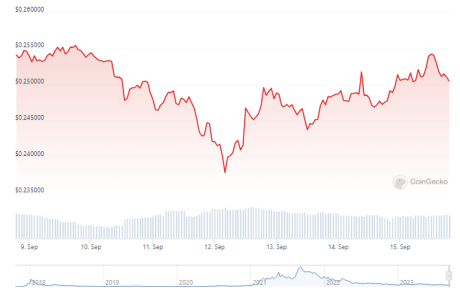
Looking further ahead, the midterm outlook for ADA remains uncertain. The resistance levels set by Bitcoin are acting as a formidable barrier in the cryptocurrency market, making ADA a less favorable candidate for a bullish breakout.
While there are positive signs of potential gains in the short term, the cryptocurrency faces significant challenges, particularly in breaking through dynamic resistance levels and overcoming the shadow of Bitcoin’s dominance.
Investors and enthusiasts will be closely monitoring ADA’s performance in the coming weeks to see if it can sustain its recovery and inspire confidence in a more extended bullish trend.
(This site’s content should not be construed as investment advice. Investing involves risk. When you invest, your capital is subject to risk).
Featured image from

The company emphasized its commitment to advancing AI technology for the safeguarding of democratic nations.

The Dutch bank used Tokeny’s platform to issue and manage digital green bonds operating on Polygon’s layer 2 Ethereum protocol.
Ethereum’s tokenomics exhibit deflationary tendencies one year after the pivotal proof-of-stake upgrade.
Ethereum Core Developers have officially approved EIP-7514 for inclusion in the upcoming Dencun upgrade which is slated for late 2023. This Ethereum Improvement Proposal (EIP) primarily aims to decelerate the growth rate of ETH staking, thereby providing the Ethereum community additional time to craft an improved validator reward scheme.
The main modification brought by this EIP is setting the Max Epoch Churn Limit, the validator activation queue upper limit, to a constant value of 8. Previously, the churn limit was calculated by taking “The total number of validators/65536,” which at present equates to about 12/epoch.
The decision followed an Ethereum Core Dev Meeting, as described in a tweet by Tim Beiko: “Wrapped up another Ethereum #AllCoreDevs: we covered devnet updates, additions to Dencun, and had a full overview of Reth. […] EIP-7514 will be part of the Dencun upgrade! Expect the EIP and associated CL specs PR to be updated to reflect all of this in the coming days.”
Beiko’s statement underscored the importance of this change and provided insights into the consensus among Core Developer teams. Dankrad Feist, a Researcher at the Ethereum Foundation, outlined the importance of the approval. Feist stated:
My reasoning on why I’m for EIP-7514. It is currently unclear if (especially liquid) staking will keep growing indefinitely. In the case that the withdrawal queue does not empty over the next few months, the lower churn limit will give the Ethereum community the time needed to research, debate and implement solutions.
The staking ratio’s continual rise could result in a diminishing amount of liquid ETH available for trading. Should the staking ratio near 100%, it might produce a supply scarcity, thereby influencing the ETH price positively. However, from the information presented, Ethereum developers are not advocating for this scenario due to potential technical and security implications.
EIP-7514, therefore, indirectly impacts the ETH price by manipulating its supply side, though immediate, direct effects on the price aren’t anticipated. Instead, any potential influence on price would likely manifest over an extended period.
The motivation behind EIP-7514, as detailed on GitHub, is to “mitigate the negative externalities of very high level of total ETH supply staked before a proper solution is implemented.” If the deposit queue stays 100% full, the share of ETH supply staked will reach 50% by May 2024, 75% by September 2024, and 100% by December 2024.
Remarkably, the modest returns don’t necessarily deter further capital staking, especially with the frequently substantial and erratic returns from MEV. Therefore, EIP-7514 serves as an interim measure, buying time for the community to deliberate and develop comprehensive solutions to the emerging challenges.
In summary, while the immediate effects of EIP-7514 on the ETH price remain to be seen, its long-term implications, especially in terms of staking growth and supply side management, could be substantial. The community and investors alike will closely monitor the aftermath of this EIP’s implementation in the Dencun upgrade.
At press time, ETH was trading at $1,628. On Monday, ETH price bounced off the 78.6% Fibonacci retracement level at $1,536. A breakout above the 20-day EMA at $1,639 and consequently above the 61.8% Fibonacci level at $1,665 is critical to maintain upside momentum.
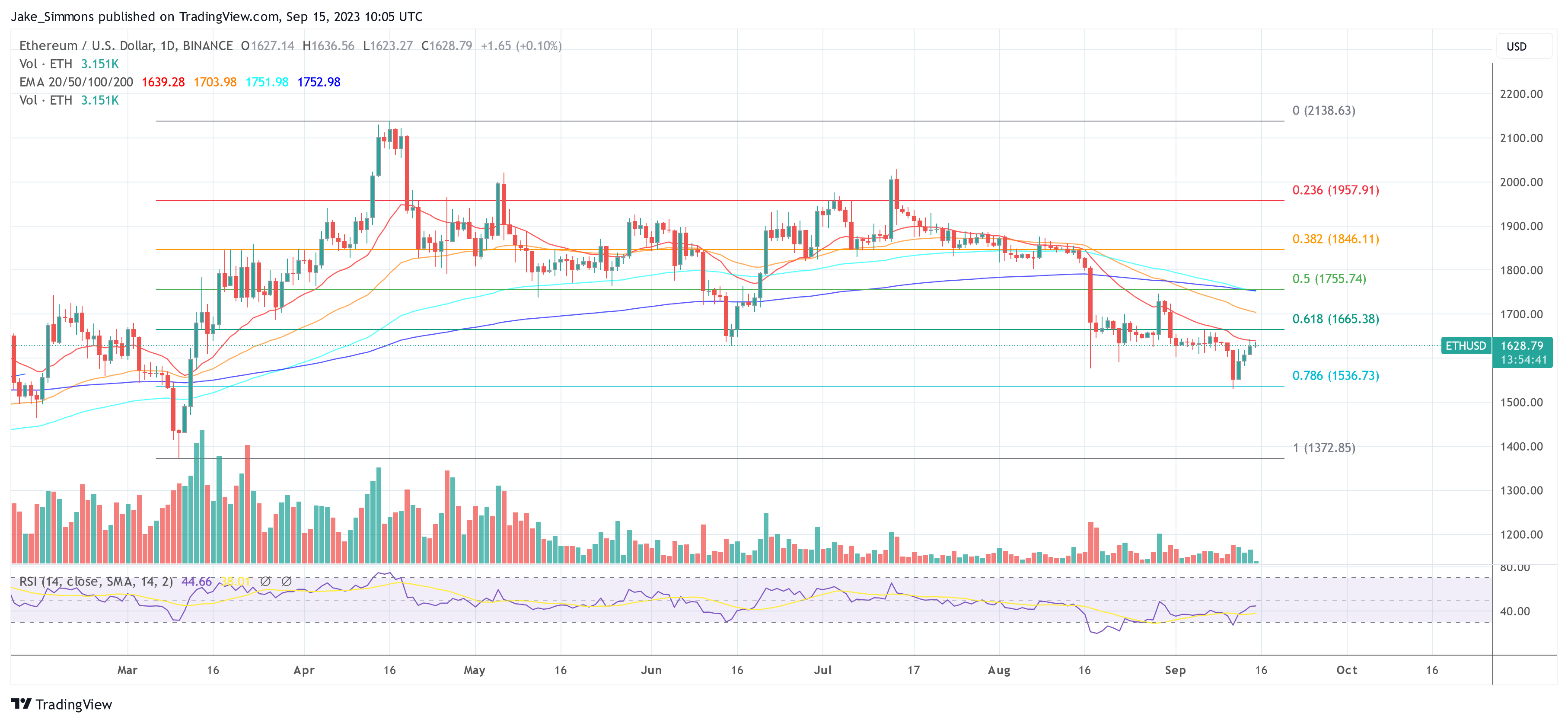

Bitcoin explorer Mempool shared blockchain data that confirmed the funds were sent back on Sept. 15.
Celsius had previously claimed hundreds of millions in damages in a squabble over unpaid dues that led to its mining rigs being powered down.

Johnny Ng of Hong Kong’s Legislative Council said he “sincerely invites” Vitalik Buterin to Hong Kong to better understand the situation regarding its crypto-friendliness.

Germany’s blockchain sector saw a total of $355 million in venture capital funding across 34 deals, which is a 3% year-on-year increase.

Bitcoin analysis increasingly believes that this cycle’s BTC price lows are done and dusted.

Deaton is known for his active engagements in legal proceedings and discussions surrounding cryptocurrency regulations and legal actions.

SEC said in a court filing that Binance.US has produced only 220 documents during the discovery process many of which were “unintelligible screenshots and documents without dates or signatures.”
In recent days, Bitcoin has shown signs of a potential reversal, with the cryptocurrency charting three consecutive green daily candles. The last time such a pattern was observed was early July and between mid and late June, when Bitcoin rallied from just under $25,000 to over $31,000. This shift in price dynamics has led to a change in market sentiment, with the bearish outlook slowly giving way to a more bullish perspective.
While Bitcoin has successfully averted the confirmation of a double top on the 1-week chart fo the moment, this price action has fueled discussions among analysts about the possibility of Bitcoin forming a double bottom pattern, a significant technical indicator.
A double bottom is a classic technical analysis pattern that signifies a potential trend reversal from bearish to bullish in markets. It is characterized by two distinct troughs or lows in the price chart, separated by a peak or a minor high in between. The pattern resembles the letter “W,” with the first trough indicating a significant low, followed by a temporary rebound, and then a second trough, usually near the same price level as the first. A valid double bottom is confirmed when the price breaks above the peak or resistance level between the two troughs, signaling a potential upward trend reversal.
Rekt Capital, a renowned crypto analyst, recently shared his insights suggesting that Bitcoin’s current price pattern in the weekly chart resembles a double top, which typically indicates a bearish reversal. This pattern is characterized by an ‘M’ shape. However, for this to be confirmed, the price would need to break down from the $26,000 support. At press time, Bitcoin was trading at $26,618, successfully fending off the double top validation at the moment.
On the flip side, a double bottom, which forms a ‘W’ shape, would require Bitcoin to rebound from the $26,000 mark and tweeted today, “Could this BTC Double Top actually be a Double Bottom? And the simple answer is – technically, yes. […] But for BTC to form a Double Bottom, it would need to rebound from $26k and rally to $30.6k (which is its validation point).”
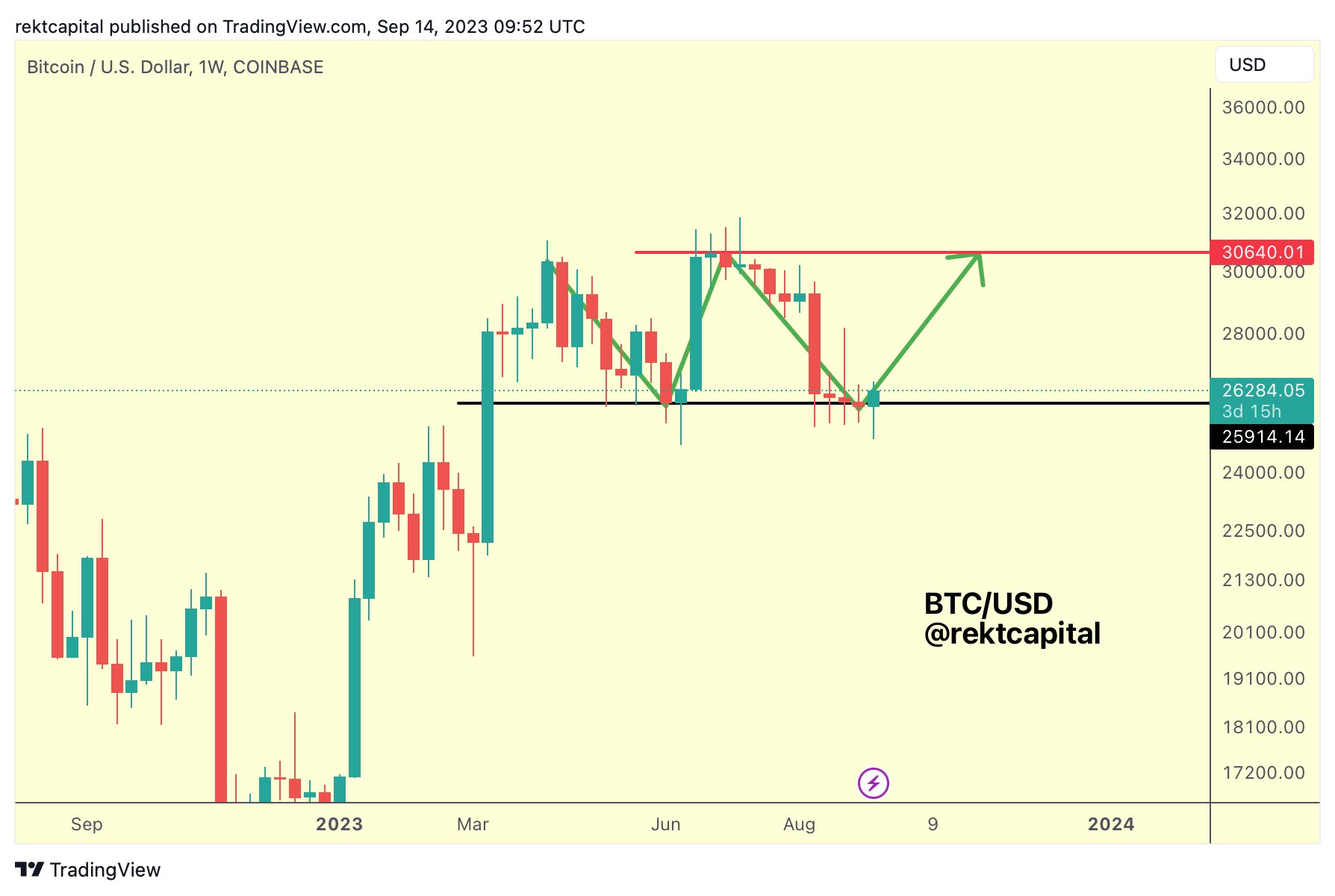
He further highlighted the challenges Bitcoin faces, noting the uncertainty surrounding the $26k support level and the numerous confluent resistances ahead, which might hinder the completion of the double bottom formation. Rekt Capital elaborated on the significance of the $26,000 level, tweeting, “It looks like BTC may be choosing the ‘relief rally’ route first in an effort to potentially turn old support into new resistance. The black Monthly level (~$27,200) is approximately confluent with the Bull Market support band as well.”
He also pointed to Bitcoin’s recent bearish monthly candle close for August, emphasizing that Bitcoin closed below approximately $27,150, thereby confirming it as a lost support. Therefore he warns that the current price move by Bitcoin could only be a relief rally to confirm $27,150 as new resistance before dropping into the $23,000 region.
“It’s possible BTC could rebound into ~$27,150, maybe even upside wick beyond it this September. […] $23,000 is the next major Monthly support now that ~$27150 has been lost,” he remarked.
So it’s clear that BTC has a major resistance level of $27,150 to break before the bulls can even dream of confirming a double bottom pattern. But there are also other key resistances to overcome before $30,600 can be breached and the double bottom confirmed.
On-chain analysis firm CryptoQuant emphasized the role of short-term Bitcoin holders, who often provide the liquidity for significant price movements. According to their data, the break-even price for these holders lies between $27,500 and $29,000. If Bitcoin remains below these levels for an extended period, these holders might be incentivized to sell, potentially exerting downward pressure on the price:
The more time we spend below these price levels, the more incentive there will be to exit liquidity from the market, and the basis condition for the return of the upward trend of Bitcoin depends on the price jump above the short-term realized prices.
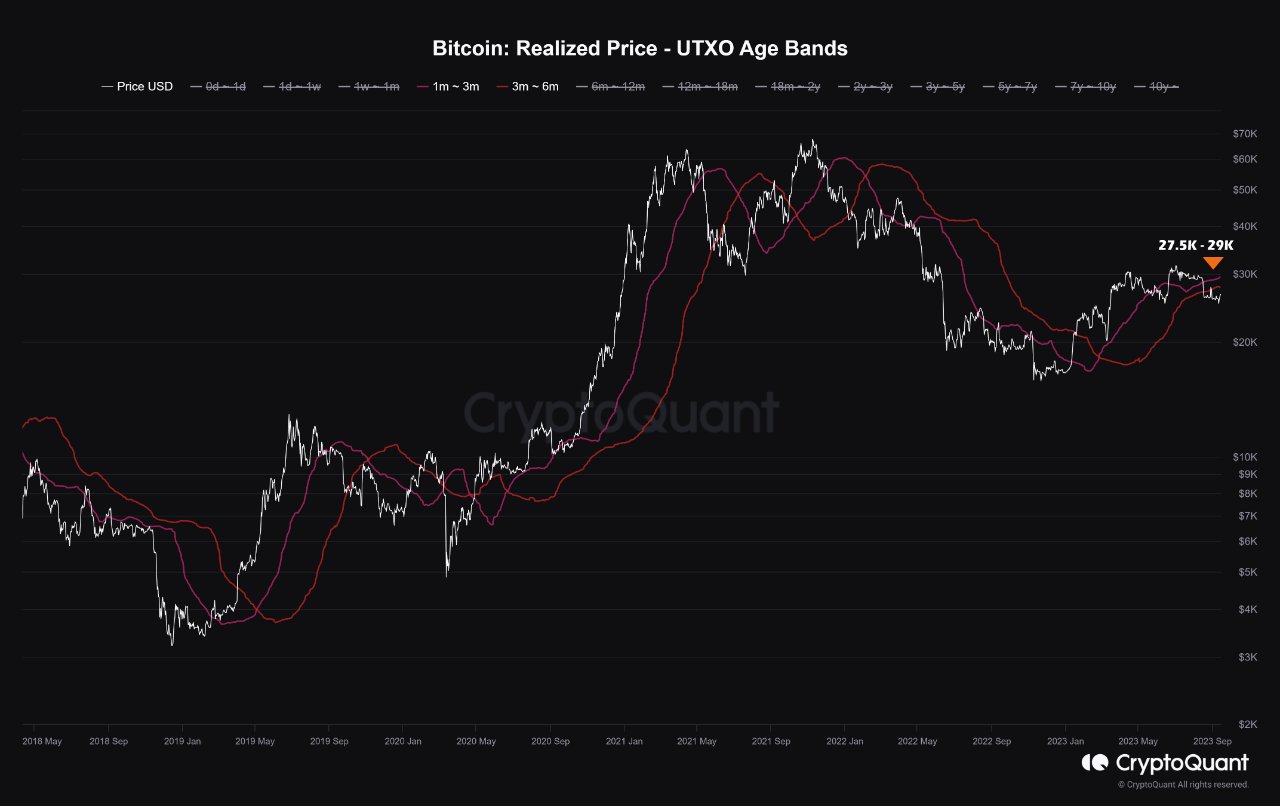
On the 4-hour time frame, BTC needs to overcome three major resistances: $26,857 (38.2% Fibonacci retracement level), $27,365 (23.6% Fibonacci retracement level) and $28,186 (post-Grayscale high from August 29th).
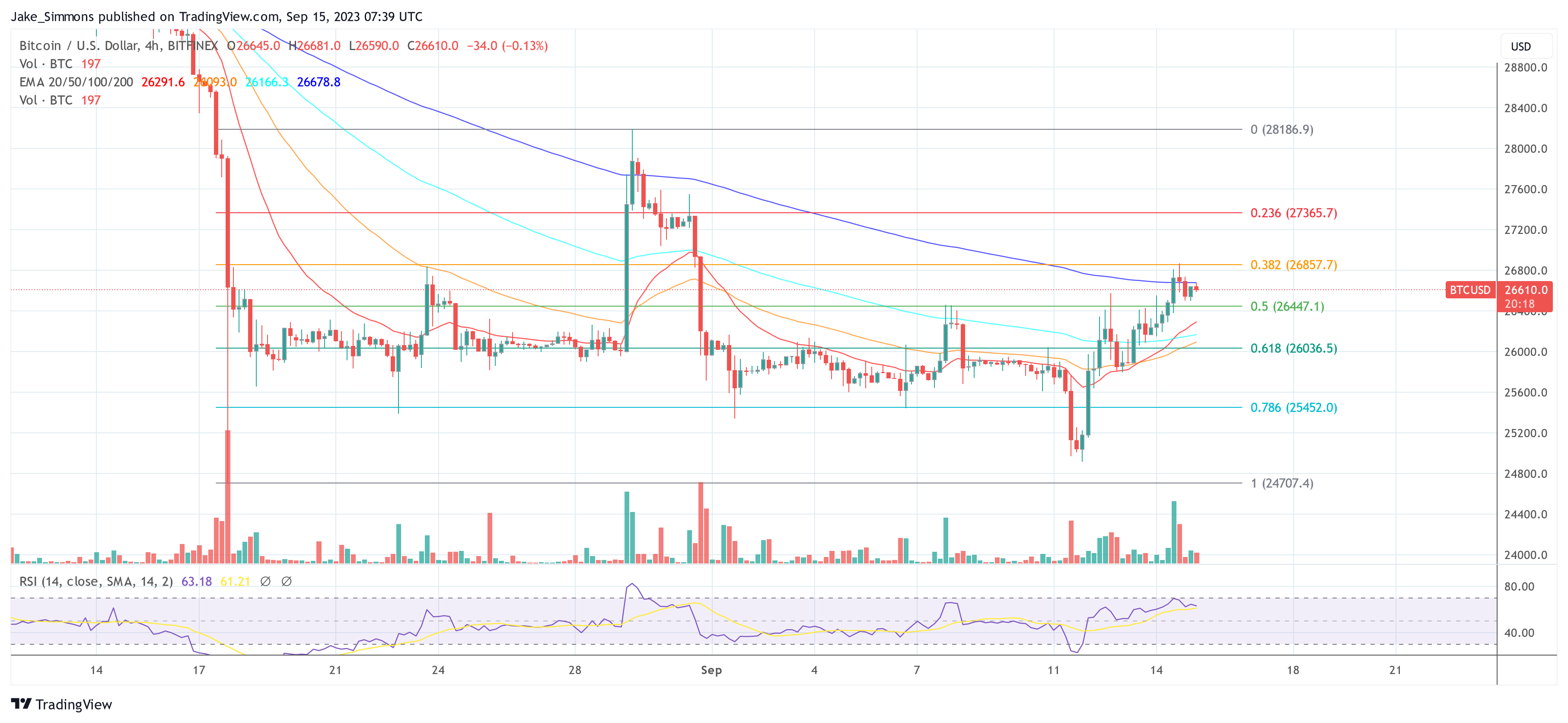

While Hong Kong grabbed the top spot with a crypto readiness score (CRS) of 8.36, the United States fell down a spot to third place after recording a fall of 6.5% in its CRS score — from 7.7 in 2022 to 7.25.